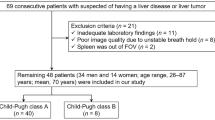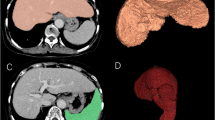Abstract
Rationale: It is generally known that scintigraphy of99mTc diethylenetriamine pentaacetic acidgalactosyl human serum albumin (99mTc-GSA) is useful for assessing hepatic functional reserve. For hepatic functional indicators, the index of the calculated planar image has been used in previous studies. However, there have been few reports that suggest that the indicators calculated from static SPECT data would be useful for the assessment of hepatic function. The aims of this study were to establish a simple method for assessing hepatic functional reserve using the liver SPECT of99mTc-GSA and to apply this method for rich stratification in patients with chronic hepatic diseases.Methods: A liver phantom (a 50% concentration of99mTc solution) was used to compare the planar and SPECT methods. According to the definition of the new indicator, the liver SPECT of99mTc-GSA was divided by a syringe SPECT of99mTc-GSA and was called the liver uptake ratio (LUR). We correlated the LUR and the liver uptake ratio calculated according to the blood-sampling method.99mTc-GSA SPECT was performed in 137 patients with hepatic diseases, including chronic hepatic diseases, and 20 healthy volunteers. The LUR was correlated between the formed subtypes for all subjects.Results: The acquired phantom-count ratio calculated by the SPECT method was more accurate than that acquired by the planar method. A good correlation was obtained between the LUR and the blood-sampling method (r=0.971). The LUR was significantly lower in subjects with severe cirrhosis than in healthy subjects or those with chronic hepatitis and mild cirrhosis, and it was significantly lower in subjects with chronic hepatitis and mild cirrhosis than in healthy subjects. The LUR was significantly correlated with other hepatic function tests. Based on LUR, the chronic hepatic diseases were divided into two groups: Group A, with LURs 30% and higher, and Group B, with LURs below 30%. An LUR of 30% marked the 25th percentile of the mildcirrhosis group. The cumulative survival rates were lower in Group B than in Group A.Conclusion: The SPECT method was superior to the planar method for assessing LURs. LUR was a suitable inducator of99mTc-GSA clearance from the blood pool and of binding to the asialo-glycoprotein receptor. LUR is a simple and clinically useful indicator for the assessment of hepatic functional reserve in chronic hepatic diseases.
Similar content being viewed by others
References
Kudo M, Ikekubo K, Todo A, Mimura J, Okabe Y, Kashida H, et al. Hepatic receptor imaging with Tc-99m GSA: Estimates of liver function in acute liver disease.Nippon Shokakibyo Gakkai Zasshi 1992; 89 (3): 616–626.
Torizuka K, Ha-Kawa SK, Kudo M, Kubota Y, Yamamoto K, Itoh K, et al. Phase III multi-center clinical study on99mTc-GSA, a new agent for functional imaging of the liver.KAKU IGAKU (Jpn J Nucl Med) 1992; 29 (2): 159–181.
Torizuka K, Ha-Kawa SK, Kudo M, Kitagawa S, Kubota Y, Tanaka Y, et al. Phase II clinical study on99mTc-GSA, a new agent for functional imaging of the liverKAKU IGAKU (Jpn J Nucl Med) 1992; 29 (1): 85–95.
Sawamura T, Nakada H, Hazama H, Shiozaki Y, Sameshima Y, Tashiro, Y. Hyperasialoglycoproteinemia in patients with chronic liver diseases and/or liver cell carcinoma.Gastroenterology 1984; 87: 1217–1221.
Kubota Y, Kitagawa S, Inoue K, Ha-Kawa SK, Kojima M, Tanaka Y. Hepatic functional scintigraphic imaging with technetium-99m galactosyl serum albumin.Hepatogastroenterology 1993; 40 (1): 32–36.
Hwang EH, Taki J, Shuke N, Nakajima K, Kinuya S, Konishi S, et al. Preoperative assessment of residual hepatic functional reserve using99mTc-DTPA-galactosyl-human serum albumin dynamic SPECT.J Nucl Med 1999; 40 (10): 1644–1651.
Sasaki N, Shiomi S, Iwata Y, Nishiguchi S, Kuroki T, Kawabe J, et al. Clinical usefulness of scintigraphy with99mTc-galactosyl-human serum albumin for prognosis of cirrhosis of the liver.J Nucl Med 1999; 40 (10): 1652–1656.
Kira T, Tomiguchi S, Kira M, Ohyama Y, Takahashi M. Quantitative evaluation of the hepatic functional reserve using technetium-99m DTPA-galactosyl human serum albumin before and after transjugular intrahepatic portosystemic shunt.Eur J Nucl Med 1997; 24 (10): 1268–1272.
Onodera Y, Takahashi K, Sugai Y, Yoshino M, Komatani A, Yamaguchi K, et al. Evaluation of the liver uptake rate measured by99mTc-GSA SPECT to assess liver function.KAKU IGAKU (Jpn J Nucl Med) 1999; 36 (1): 37–44.
Sugahara K, Togashi H, Shinzawa H, Matsuo T, Takeda Y, Miyano S, et al. Analysis of liver single-photon emission computed tomography in a case of fulminant hepatic failure.Tohoku J Exp Med 1999; 188 (3): 257–263.
Sugai Y, Komatani A, Hosoya T, Yamaguchi K. Response to percutaneous transhepatic portal embolization: New proposed parameters by99mTc-GSA SPECT and their usefulness in prognostic estimation after hepatectomy.J Nucl Med 2000; 41 (3): 421–425.
Nakajima K, Kinuya K, Mizutani Y, Hwang EH, Michigishi T, Tonami N, et al. Simple scintigraphic parameters with Tc-99m galactosyl human serum albumin for clinical staging of chronic hepatocellular dysfunction.Ann Nucl Med 1999; 13 (1): 5–11.
Hashimoto M, Watanabe G. Hepatic parenchymal cell volume and the indocyanine green tolerance test.J Surg Res 2000; 92 (2): 222–227.
Watanabe Y, Kumon K. Assesment by pulse dye-densitometry indocyanine green (ICG) clearance test of hepatic function of patients before cardiac surgery: Its value as a predictor of serious postoperative liver dysfunction.J Cardiothorac Vasc Anesth 1999; 13 (3): 299–303.
Matsui Y, Tu W, Kitade H, Nakagawa A, Kamiya T, Kwon AH, et al. Hepatocyte volume as an indicator of hepatic functional reserve in cirrhotic patients with liver tumors.J Gastroenterol Hepatol 1996; 11 (6): 540–545.
Gordon I, Anderson PJ, Orton M, Evans K. Estimation of technetium-99m-MAG3 renal clearance in children: Two gamma camera techniques compared with multiple plasma samples.J Nucl Med 1991; 32 (9): 1704–1708.
Author information
Authors and Affiliations
Corresponding author
Rights and permissions
About this article
Cite this article
Onodera, Y., Takahashi, K., Togashi, T. et al. Clinical assessment of hepatic functional reserve using99mTc DTPA galactosyl human serum albumin SPECT to prognosticate chronic hepatic diseases —Validation of the use of SPECT and a new indicator—. Ann Nucl Med 17, 181–188 (2003). https://doi.org/10.1007/BF02990020
Received:
Accepted:
Issue Date:
DOI: https://doi.org/10.1007/BF02990020




